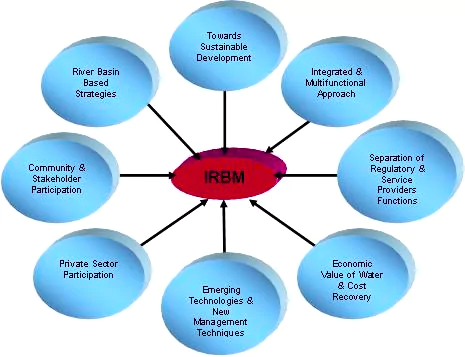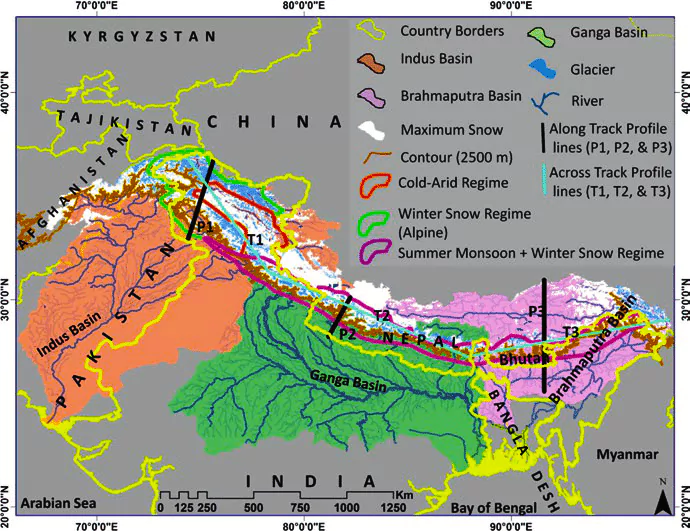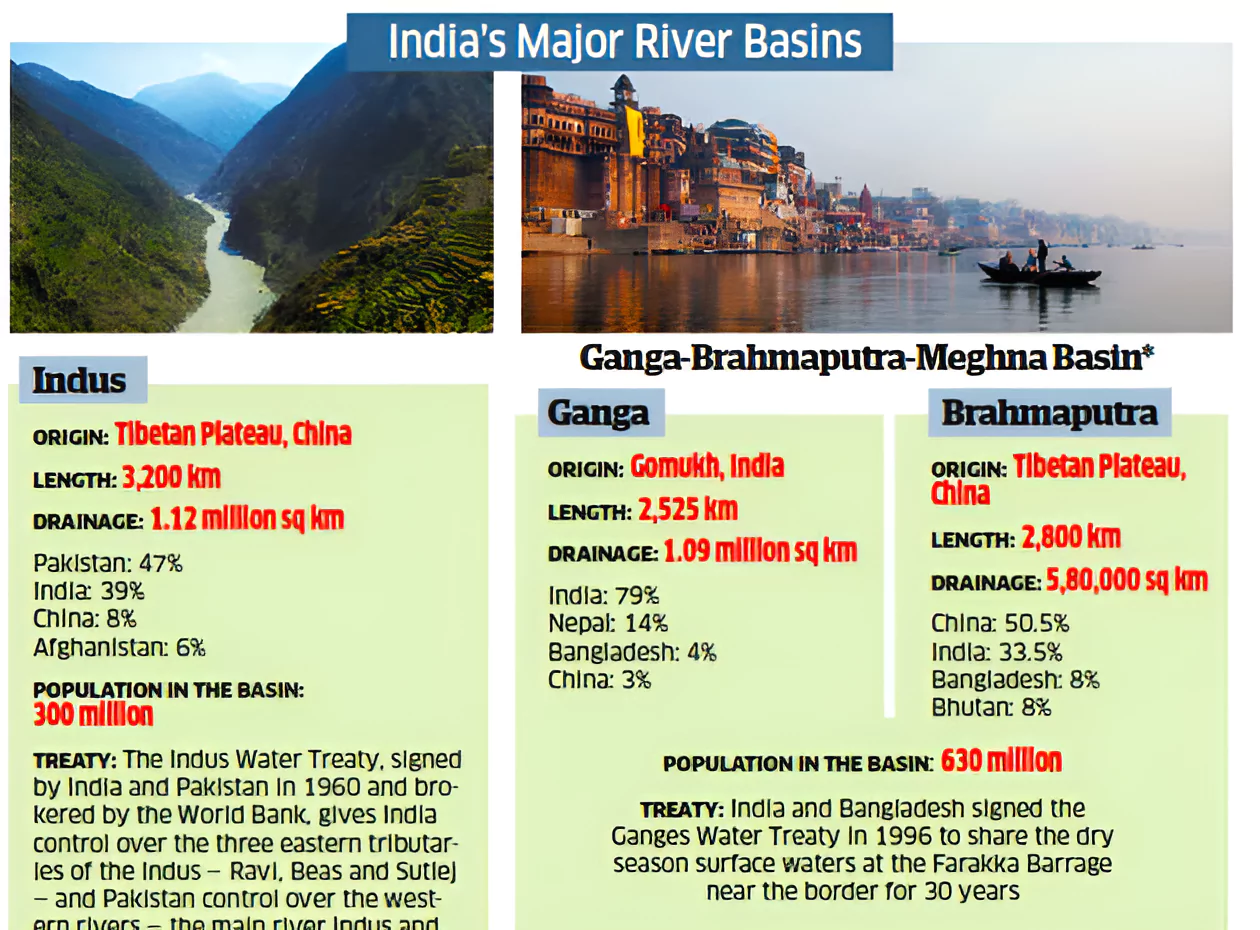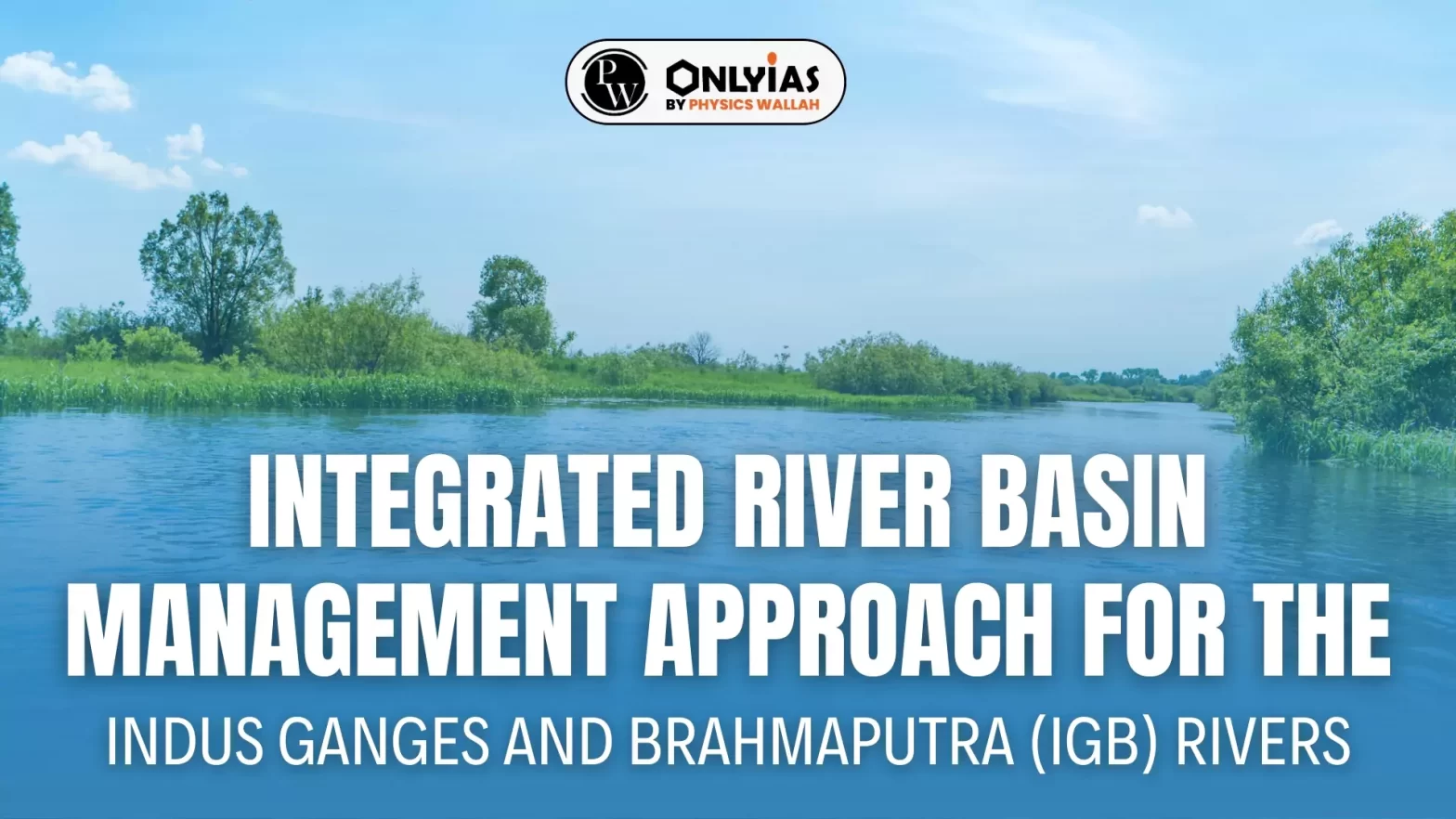Context
The recent report by the Kathmandu-based International Centre for Integrated Mountain Development (ICIMOD) and the Australian Water Partnership (AWP) describes climate change as the “urgent catalyst” for collaboration over three key river basins in Asia: the Indus, the Ganga, and the Brahmaputra.
- As per the UN Chief, major Himalayan rivers like the Indus Ganges and Brahmaputra (IGB) will see their flows reduced as glaciers recede.
About the International Centre for Integrated Mountain Development (ICIMOD)
|
About Integrated River Basin Management (IRBM)
- Refers: Integrated River Basin Management (IRBM) refers to a basin-wide approach to river planning, backed by quality data sharing on water availability, biodiversity and pollution between all stakeholders.
- Coordinated Management: IRBM is the process of coordinating conservation, management and development of water, land and related resources across sectors within a given river basin, to maximize the economic and social benefits derived from water resources equitably while preserving and, where necessary, restoring freshwater ecosystems.
- A Way For Future Collaboration: By encouraging riparian countries to focus on shared challenges and opportunities.
 Suitability: It is mainly suitable for India and other developing countries as it envisages equitably maximising socio-economic benefits ensuring the sustainability of freshwater ecosystems. Suitability: It is mainly suitable for India and other developing countries as it envisages equitably maximising socio-economic benefits ensuring the sustainability of freshwater ecosystems. - Deals With: It is concerned with identifying structural and non-structural measures to ensure the water availability, overcoming its spatial & temporal variability to meet development objectives, subject to various technological, social and financial constraints.
Seven Key Elements of Integrated River Basin Management (IRBM):
- A long-term vision for the river basin, agreed to by all the major stakeholders.
- Integration of policies, decisions, and costs across sectoral interests such as industry, agriculture, urban development, navigation, fisheries management and conservation, including through poverty reduction strategies.
- Strategic decision-making at the river basin scale, which guides actions at sub-basin or local levels.
- Effective timing, taking advantage of opportunities as they arise while working within a strategic framework.
- Active participation by all relevant stakeholders in well-informed and transparent planning and decision-making.
- Adequate investment by governments, the private sector, and civil society organizations in capacity for river basin planning and participation processes.
- A solid foundation of knowledge of the river basin and the natural and socio-economic forces that influence it.
A Multidisciplinary Approach:
- It calls for integration at regional, national and possibly international scale. It enables a holistic approach for addressing issues related to water resources in a river basin.
- Its Major Disciplines:
-
- Hydrology: Concerned with quantifying natural water distribution in time and space (assessment of water resources).
- Hydraulic Engineering: Concerned with design and management of structural measures whereby water can be stored and distributed in time and space.
- Environmental Engineering: Concerned with quantifying water quality in time and space, and with waste water treatment processes whereby this can be altered to accord with water quality standards for river water etc.
- Social Sciences: Concerned with formulating objectives of development, with assessment of water demand and with water governance and public participation.
- System Analysis: Interacting roles of above disciplines can best be studied through the medium of systems analysis.
|
Crucial Insights of the Report
- High Dependency on Rivers: People in India, China, Pakistan, Afghanistan, Nepal and Bhutan depend on these three IGB rivers for their food and water security.
- Fragmented Governance: Despite the urgent need for collective action, governance within these basins remains fragmented, with limited multilateral agreements facilitating basin-wide collaboration.
- No Addresal to Climate Change: Existing treaties and agreements have often failed to address the broader impacts of climate change or involve marginalised stakeholders.
- No Multilateral Treaty: There are bilateral treaties such as the Indus Water Treaty between India and Pakistan or agreements on water data sharing and on Brahmaputra between India and China, however, no multilateral agreements or treaties exist.
- 600 mn Indians, 29 mn from Nepal and millions in Bangladesh live in the Ganga river basin area. However, there is no agreement involving Nepal, India and Bangladesh.
- The HKH are the freshwater sources of South Asia and parts of Southeast Asia. Water originating from their snow, glaciers, and rainfall feeds the 10 largest river systems in Asia.
|
- Data and Knowledge Gaps: There were substantial data and knowledge gaps across the Ganga river basin regarding social, economic and environmental realities and even on water usage.
- Multifaceted Concerns: The Elevating River Basin Governance and Cooperation in the Hindu Kush Himalaya Region (HKH) report series zeroes in on key economic, ecological, energy, social, geopolitical and governance issues.
- The collective action in the region is fraught but, with governments’ water, food, energy and security strategies at stake, also “hugely urgent.”

About River Basin
- It is an area drained by a river and all of its tributaries.
- It is made up of many different watersheds.
- Watershed: It is a small version of a river basin.
River Basins and Threats
The three rivers- Indus Ganges and Brahmaputra provide food and water security to some of Asia’s most vulnerable communities, as well as underpinning industry, and industrial and economic policies in one of the most populous and geopolitically sensitive zones in the world.
-
The Ganges Basin:
- It is often regarded as sacred and essential to more than 600 million individuals across the Indian subcontinent.
- States Flowing Through: Uttarakhand, Uttar Pradesh, Bihar, Jharkhand, West Bengal, etc.
- Threats: The impacts of climate change are exacerbating existing challenges, particularly in the form of escalating flooding and droughts.
- The monsoon season now brings devastating floods while dry seasons worsen water scarcity, especially in downstream areas such as Bangladesh.
- Anthropogenic Activities: Rapid industrialisation, urbanisation and intensive agricultural practices are severely impacting the river’s ecological health.
- The indiscriminate discharge of sewage and industrial waste poses significant risks to both human health and the environment.
- Impact on Vulnerable Groups: These climate-related hazards affect vulnerable groups, including women, people with disabilities and marginalised communities.
-
The Indus Basin:
- The Indus River is a lifeline for more than 268 million people across Pakistan, India, Afghanistan, and China.
- States Flowing Through: Jammu & Kashmir, Himachal Pradesh, Punjab, Rajasthan, Haryana and Chandigarh (UT).
- It holds a hydropower potential of 35,700 MGWatts, only 12% of which is currently being harnessed, and is important for India, Pakistan, Afghanistan and China’s energy strategies.
 Threats: It is under unprecedented stress due to climate change.
Threats: It is under unprecedented stress due to climate change.
- Rising temperatures, erratic monsoons, and environmental degradation are pushing the basin towards a crisis point.
- The scale of climate change impacts is undermining food security, livelihoods and water security.
- Variations in the timing and intensity of monsoon rains and environmental degradation, including increasing agricultural and industrial pollution adversely affecting freshwater fisheries and eroding the ecological health of the river.
- Impact on Vulnerable Groups: These challenges with the socio-economic vulnerabilities, further exacerbating the plight of marginalised communities.
-
The Brahmaputra Basin:
- It is essential for 114 million people in Bangladesh, India, China and Bhutan – and accounts for 30% of India’s freshwater sources.
- States Flowing Through: Arunachal Pradesh, Assam, and others.
- It has the immense hydropower potential that both China and India aim to tap.
- Threats: The climate change along with dams and development work is escalating floods and droughts, particularly in its lower basin.
- While currently there are no major water diversions in the basin, upstream dam construction and climate change projections are likely to reduce dry season flows in downstream areas, affecting millions of lives.
- With rise in glacial melt rates, impacting water availability across the region.
- Impact on Vulnerable Groups: The vulnerability of women, poor and indigenous and marginalised communities is increasing with changing socioeconomic drivers converging with projected climate impacts.
Recommendations of the Report & Way Forward
-
Need For Bottom-up Approach & Harnessing Indigenous Knowledge:
- It is essential for effective climate adaptation. Governments need to empower local communities with knowledge and technology to nurture their resilience in the face of rising uncertainty.
- Local communities can act to resolve problems quickly and effectively during a crisis.
- Programmes such as “Indus Calling” empower communities with information and tools for better water management and resilience building.
-
Data Development and Enhancement:
- The data gaps on river basins need to be sorted out for better water management, early warning and to facilitate disaster management.
- Developing the data using a ‘whole basin’ research approach would yield additional benefits- reliable water accounting and supply, underpin strategic basin planning, increase transboundary understanding of the long-term impacts of climate change, etc.
- Hydrosolidarity: It describes an increasingly integrated approach to managing water resources that relies heavily on participation and coordination among community stakeholders , water-related management agencies and local, state, and national governments.
- Climate Diplomacy: It is the practice and process of creating an international climate change regime and ensuring its effective operation.
- It is evolving in scope and complexity as the climate regime shifts its focus to implementation and climate risk management.
|
-
Negotiations on IRBM Approaches:
- Encourage negotiations and build fresh consensus, especially by rejuvenating existing treaties and potentially new forms of cooperation through the deployment of ‘integrated river basin management’ (IRBM) approaches.
-
Regional Cooperation:
- There is a transboundary nature of climate impacts, which requires regional cooperation.
- Initiatives such as the “HKH Call to Action” provide a framework for collaborative action, fostering trust among basin states and informing evidence-based decision-making.
-
Adopt Long-Term Strategic & Inclusive Approaches:
- There is an opportunity to adopt more inclusive and resilient approaches to basin governance, leveraging diverse perspectives and expertise.
- There is a need for long-term strategies that must prioritise adaptive infrastructure, flexible governance structures, and inclusive policies to ensure reliable water supply amid climatic uncertainties.
-
Trust Building:
-
- There is a need for greater ‘hydro-solidarity’ and climate diplomacy among researchers to build trust between countries and move towards greater dialogue.
Conclusion
With climate change compounding the existing pressures on water resources, and increasing risks from floods, land erosion, and salinity, there is need for researchers, scientists, civil society, communities, and officials around the three crucial IGB river basins that span Pakistan, China, Afghanistan, Nepal, India, Bangladesh and Bhutan to join forces to avert “enormous and growing” humanitarian, ecological, and economic risks.
To get PDF version, Please click on "Print PDF" button.


 Threats: It is under unprecedented stress due to climate change.
Threats: It is under unprecedented stress due to climate change.
